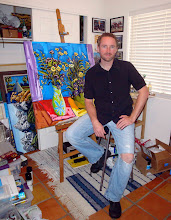
This week I am working on a 20 x 24 vertical Saguaro landscape with blooming paloverdes in the distance. I'm also busy organizing the advertisements, invitations, and the special online exhibits that will go along with my January 16th show at the Max Gallery in Tucson. I hope everyone has had a wonderful holiday season, and we look forward to a happy and fruitful 2009. This coming year will see the birth of my son, in March - and on top of all the great things that have come to pass for my wife and I, we are the MOST excited about this little man who is soon to come into our lives.
I'm currently reading a book by Gregory Curtis called "The Cave Painters, Probing the Mysteries of the World's First Artists". This is a study of the primitive arts that existed in the Paleolithic era of early man. The books spends a great deal of time talking about world landmarks such as Lascaux, the beautiful painted cave in France that features the "Hall of Bulls", which I myself painted a rendering of last year. I've always been deeply fascinated by art of this kind, and only recently did a begin to ask myself why.
There is always in me a great love and respect of the primitive. That is to say - what art would be without any social conventions or training. Paul Gauguin sought such a place where he could establish his vision of art free of western social norms, in a raw, primitive environment. Picasso, after mastering representational painting by the age of 14, spent much of the rest of his life in a process of exploration that involved some drastic simplifications, and complexities, that strayed far from his classical training - and resulted in, at least on some of his canvases, very primitive works. Picasso had a great fascination with masks - and some of the Fauvist painters looked to African crafts for inspiration in the qualities of simplicity.
I think that I respect the primitive works on some level due to my own lack of training in the arts. I took one drawing class in college and absolutely hated it. Drawing was something I enjoyed all my life, even as a small boy - and to have the act reduced to something the professor wanted to see led me to the conclusion that most art professors want artists that will just paint or draw like them. They see themselves as an ideal, and thus seek to conform others to it. I dare say not all fall into this category, but I'm sure many do.
It seems to me that primitive artists very likely didn't have the hangups that come with the rigid formulations of training. None the less, many of them displayed a great deal of talent - the ability to render colors and shapes impressively, and the ability to have an eye for composition and perspective. That is what appeals to me on canvas. The seeking of something raw and beautiful - rough and luminous at the same time. I enjoy a perfect Michelangelo or Leonardo as much as the next guy - but it never gets to the root of my own artistic feeling. My feeling in front of the canvas is a feeling that is hard and rough. My work shows it, and that's certainly deliberate.
So when I discovered through books the wonderful painted caves of France I immediately felt a connection rooted from those early artists and running right up to contemporary painters like myself. I painted a large wall-sized work called "The Dawn of Painting" which depicts one scene from the Hall of Bulls at Lascaux. I've never shown the painting outside of my home, but countless friends have commented on it. It has simply my homage to those wonderful early artists whose works still survive.
I feel it is crucial to the artist to get down to the core of what art could be - art with no hangups or framework. To answer the question of what the soul would put on canvas before it asked the permission of a professor or classicist to feel what it is feeling. An honest urge - a true expression. The cave painters did not need a university or art school to make compelling images, they just did it. Let art be as natural as the rain. Let it speak in honest ways. Drop the filters and see the uncut version. That is the language of the human heart. The cages came after.

1 comment:
Very nice painting. The complex painted caves of Lascaux are located in the Dordogne region. The awe-inspiring paintings are also described as ‘the antediluvian Sistine Chapel’.1200 visitors daily visit the cave. The initial climatic situation had been re-build and maintained with the assistance of a fully-automated system. The original caves were made in 1980 called as Lascaux II.For more details refer Caves Of Lascaux
Post a Comment